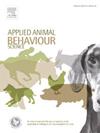Sniffing for fun: Evaluating the effect of olfactory enrichment on cats’ toy preference and interaction
IF 2.2
2区 农林科学
Q1 AGRICULTURE, DAIRY & ANIMAL SCIENCE
引用次数: 0
Abstract
Play is a critical natural behavior in domestic cats. Toys and olfactory enrichment are common methods used to encourage play; however, no research has previously evaluated how olfactory enrichment affects toy interaction in cats. We hypothesized that the addition of cats’ preferred odor to a toy would increase toy interaction. Therefore, the objective of this study was to evaluate if adding cats’ preferred odor to moving or stationary toys increased toy interaction. Pet cats (N = 31) participated in three, 5-minute free operant preference assessments where we first evaluated their preferred odor from a set of three different odors (i.e., catnip, silver vine, and Feliway®) and a control (i.e., unscented) and subsequently evaluated their interaction time with a moving or stationary toy with and without their preferred odor, independently. Cats’ behavior during the different preference tests was video recorded and the amount of time they interacted with the testing stimulus was measured. Preference for an odor or a toy was defined as the stimulus that received the most interaction time. Cats interacted with catnip (85.24 s; 95 % CI [59.64, 110.85]) and silver vine (57.99 s; 95 % CI [35.32, 80.66]) more than with the control (3.36 s; 95 % CI [0.98, 5.75]) and Feliway® (8.11 s; 95 % CI [4.24, 11.97]). Although there was no statistical difference, more cats showed a preference for catnip (n = 19) than silver vine (n = 12). Subsequently, each cat’s preferred odor (catnip or silver vine) was added to moving and stationary toys to evaluate the effect of olfactory enrichment on toy interaction. A linear mixed model was used to assess the effect of odor (scented vs unscented), toy type (stationary vs moving) and their interaction on the amount of time cats interacted with the toys. Cats interacted significantly more with moving toys, whether scented (59.04 s; 95 % CI [28.27, 122.14]) or unscented (58.24 s; 95 % CI [27.88, 120.50]), compared to unscented stationary toys (12.27 s; 95 % CI [5.47, 26.21]). Cats interacted statistically longer with scented stationary toys (38.01 s; 95 % CI [18.02, 79.02]) than with unscented stationary toys, but their interaction with scented stationary toys did not statistically differ from their interaction with scented or unscented moving toys. These results indicate that cats prefer moving and scented stationary toys compared to unscented stationary toys. Our results highlight that using olfactory enrichment is a simple method to encourage interaction with stationary toys and play behavior to support cat welfare.
嗅探乐趣:评估嗅觉增强对猫玩具偏好和互动的影响
玩耍是家猫的一种重要的自然行为。玩具和增强嗅觉是鼓励玩耍的常用方法;然而,此前没有研究评估嗅觉增强如何影响猫对玩具的互动。我们假设,在玩具中加入猫喜欢的气味会增加玩具之间的互动。因此,本研究的目的是评估在移动或静止的玩具中加入猫喜欢的气味是否会增加玩具的相互作用。宠物猫(N = 31)参加了三次5分钟的自由操作偏好评估,我们首先从一组三种不同的气味(即猫薄荷、银藤和Feliway®)和对照(即无气味)中评估它们喜欢的气味,然后独立评估它们与带有或不带有它们喜欢的气味的移动或静止玩具的互动时间。研究人员记录了猫在不同偏好测试中的行为,并测量了它们与测试刺激相互作用的时间。对气味或玩具的偏好被定义为获得最多互动时间的刺激。猫与猫薄荷互动(85.24 s;95 % CI[59.64, 110.85])和银藤(57.99 s;95 % CI[35.32, 80.66])大于对照组(3.36 s;95 % CI[0.98, 5.75])和Feliway®(8.11 s;95 % ci[4.24, 11.97])。虽然没有统计学差异,但更多的猫对猫薄荷(n = 19)比银藤(n = 12)更偏爱。随后,将每只猫喜欢的气味(猫薄荷或银藤)添加到移动和静止的玩具中,以评估嗅觉增强对玩具相互作用的影响。一个线性混合模型被用来评估气味(有气味的和没有气味的)、玩具类型(静止的和移动的)以及它们的相互作用对猫与玩具互动时间的影响。猫与移动玩具的互动明显更多,无论是有香味的(59.04 s;95 % CI[28.27, 122.14])或无香味(58.24 s;95 % CI[27.88, 120.50]),与无气味的固定玩具相比(12.27 s;95 % ci[5.47, 26.21])。统计上,猫与有香味的固定玩具的互动时间更长(38.01 s;95 % CI[18.02, 79.02])与无气味的固定玩具相比,但他们与有气味的固定玩具的相互作用与与有气味或无气味的移动玩具的相互作用没有统计学差异。这些结果表明,与没有气味的固定玩具相比,猫更喜欢有气味的移动固定玩具。我们的研究结果强调,使用嗅觉富集是一种简单的方法来鼓励与固定玩具的互动和游戏行为,以支持猫的福利。
本文章由计算机程序翻译,如有差异,请以英文原文为准。
求助全文
约1分钟内获得全文
求助全文
来源期刊

Applied Animal Behaviour Science
农林科学-行为科学
CiteScore
4.40
自引率
21.70%
发文量
191
审稿时长
18.1 weeks
期刊介绍:
This journal publishes relevant information on the behaviour of domesticated and utilized animals.
Topics covered include:
-Behaviour of farm, zoo and laboratory animals in relation to animal management and welfare
-Behaviour of companion animals in relation to behavioural problems, for example, in relation to the training of dogs for different purposes, in relation to behavioural problems
-Studies of the behaviour of wild animals when these studies are relevant from an applied perspective, for example in relation to wildlife management, pest management or nature conservation
-Methodological studies within relevant fields
The principal subjects are farm, companion and laboratory animals, including, of course, poultry. The journal also deals with the following animal subjects:
-Those involved in any farming system, e.g. deer, rabbits and fur-bearing animals
-Those in ANY form of confinement, e.g. zoos, safari parks and other forms of display
-Feral animals, and any animal species which impinge on farming operations, e.g. as causes of loss or damage
-Species used for hunting, recreation etc. may also be considered as acceptable subjects in some instances
-Laboratory animals, if the material relates to their behavioural requirements
 求助内容:
求助内容: 应助结果提醒方式:
应助结果提醒方式:


